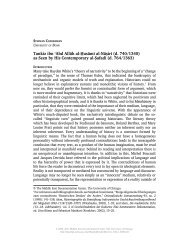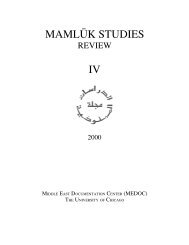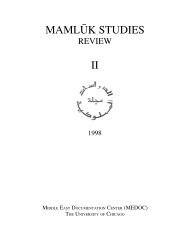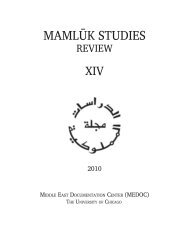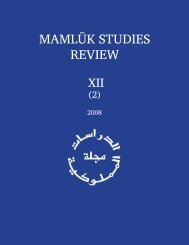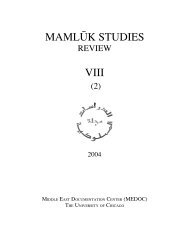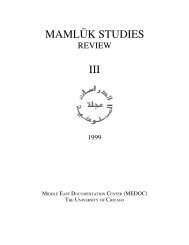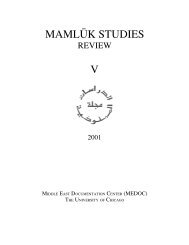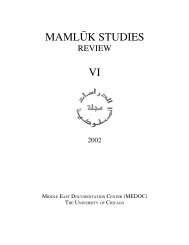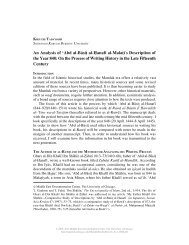Vol. VII, no. 1 (2003) - Mamluk Studies Review - University of Chicago
Vol. VII, no. 1 (2003) - Mamluk Studies Review - University of Chicago
Vol. VII, no. 1 (2003) - Mamluk Studies Review - University of Chicago
Create successful ePaper yourself
Turn your PDF publications into a flip-book with our unique Google optimized e-Paper software.
32 GEERT JAN VAN GELDER, POETRY FOR EASY LISTENING<br />
and banal. "The best <strong>of</strong> them," said Nicholson in his Literary History <strong>of</strong> the Arabs,<br />
speaking <strong>of</strong> poets in the <strong>Mamluk</strong> era, "are merely elegant and accomplished<br />
artists, playing brilliantly with words and phrases, but doing little else." 4 These<br />
words are quoted by Homerin, reviewing the neglect <strong>of</strong> poetry from the <strong>Mamluk</strong><br />
period; 5 in fairness to Nicholson, one should add that he admits that "until they<br />
have been studied with due attention, it would be premature to assert that <strong>no</strong>ne <strong>of</strong><br />
them rises above mediocrity."<br />
It is extremely unlikely that the reigning view on the superiority <strong>of</strong> the older<br />
poets will ever change, but the generally negative and disparaging remarks on<br />
post-Abbasid poetry may well be replaced by more balanced judgements as post-<br />
Abbasid poetry is slowly beginning to be investigated in more detail. Here I shall<br />
concentrate on the concept <strong>of</strong> stylistic and poetic "easiness" as we find it in Ibn<br />
H˛ijjah's work on bad|‘. Ibn H˛ijjah, poet and ka≠tib, wrote his Khiza≠nat al-Adab on<br />
the model <strong>of</strong> Sharh˝ al-Ka≠fiyah al-Bad|‘|yah by the well-k<strong>no</strong>wn poet S˝af| al-D|n<br />
al-H˛ill| (d. 749/1349): both works are commentaries on bad|‘|yah poems composed<br />
by the authors themselves, in bas|t¸ meter and rhyming in -m|, in praise <strong>of</strong> the<br />
Prophet (like, before them, al-Bu≠s˝|r|'s celebrated ode), each verse <strong>of</strong> which<br />
exemplifies a particular figure <strong>of</strong> speech or stylistic embellishment. Khiza≠nat<br />
al-Adab contains a large quantity <strong>of</strong> poetry from all ages, much <strong>of</strong> it from post-<br />
Abbasid or <strong>Mamluk</strong> times. Since <strong>no</strong>rmally a figure <strong>of</strong> speech or trope does <strong>no</strong>t<br />
exceed the compass <strong>of</strong> one or two lines, most <strong>of</strong> the quotations are short, but one<br />
also finds longer fragments and poems, including muzdawijahs <strong>of</strong> 133 and 158<br />
couplets.<br />
Most <strong>of</strong> the "embellishments" are thought <strong>of</strong> as features that are somehow<br />
changed from or added to an underlying basic utterance: a metaphor instead <strong>of</strong> the<br />
literal word, a pun, antithesis, syntactical or semantic parallelism that can be<br />
superimposed on plain expressions. Instead <strong>of</strong> adding, one could presuppose other<br />
mutations: suppression in the case <strong>of</strong> ellipsis and conciseness, permutation in the<br />
case <strong>of</strong> some syntactic rearrangements. There are also "figures" that can<strong>no</strong>t so<br />
easily be described, for instance the more impressionistic concepts <strong>of</strong> naza≠hah,<br />
"chaste diction," particularly when in biting lampoons one manages to avoid<br />
obscenities, 6 or sala≠mat al-ikhtira≠‘, "originality." 7 The same is valid for a few<br />
chapters that deal with easy diction and smooth style, which form the subject <strong>of</strong><br />
this article.<br />
4<br />
R. A. Nicholson, A Literary History <strong>of</strong> the Arabs (1907; reprint, Cambridge, 1966), 448.<br />
5<br />
Th. Emil Homerin, "Reflections on Arabic Poetry in the <strong>Mamluk</strong> Age," Mamlu≠k <strong>Studies</strong> <strong>Review</strong><br />
1 (1997): 63–85.<br />
6<br />
Khiza≠nah, 95–96/1:172–74.<br />
7 Ibid., 493–98/2:362–69.<br />
© <strong>2003</strong>, 2012 Middle East Documentation Center, The <strong>University</strong> <strong>of</strong> <strong>Chicago</strong>.<br />
http://mamluk.uchicago.edu/<strong>Mamluk</strong><strong>Studies</strong><strong>Review</strong>_<strong>VII</strong>-1_<strong>2003</strong>.pdf



